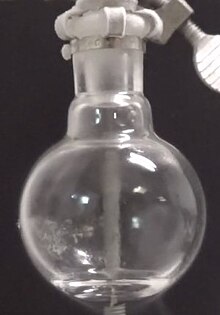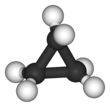
Back Siklopropaan Afrikaans حلقي البروبان Arabic Tsiklopropan Azerbaijani سیکلوپروپان AZB Цыклапрапан Byelorussian Циклопропан Bulgarian Ciclopropà Catalan Cyklopropan Czech Cyklopropan Danish Cyclopropan German
| |||
| |||

| |||
| Names | |||
|---|---|---|---|
| Preferred IUPAC name
Cyclopropane[2] | |||
| Identifiers | |||
3D model (JSmol)
|
|||
| ChEBI | |||
| ChEMBL | |||
| ChemSpider | |||
| ECHA InfoCard | 100.000.771 | ||
| KEGG | |||
PubChem CID
|
|||
| UNII | |||
| UN number | 1027 | ||
CompTox Dashboard (EPA)
|
|||
| |||
| |||
| Properties | |||
| C3H6 | |||
| Molar mass | 42.08 g/mol | ||
| Appearance | Colorless gas | ||
| Odor | Sweet, ethereal | ||
| Density | 1.879 g/L (1 atm, 0 °C) 680 g/L (liquid) | ||
| Melting point | −128 °C (−198 °F; 145 K) | ||
| Boiling point | −32.9 °C (−27.2 °F; 240.2 K) | ||
| 502 mg/L | |||
| Vapor pressure | 640 kPa (20 °C) 1350 kPa (50 °C) | ||
| Acidity (pKa) | ~46 | ||
| -39.9·10−6 cm3/mol | |||
| Hazards | |||
| Occupational safety and health (OHS/OSH): | |||
Main hazards
|
Highly flammable Asphyxiant | ||
| GHS labelling: | |||
 
| |||
| Danger | |||
| NFPA 704 (fire diamond) | |||
| 495 °C (923 °F; 768 K) | |||
| Explosive limits | 2.4 % (lower) 10.4 % (upper) | ||
| Safety data sheet (SDS) | Air Liquide | ||
Except where otherwise noted, data are given for materials in their standard state (at 25 °C [77 °F], 100 kPa).
| |||
Cyclopropane is the cycloalkane with the molecular formula (CH2)3, consisting of three methylene groups (CH2) linked to each other to form a triangular ring. The small size of the ring creates substantial ring strain in the structure. Cyclopropane itself is mainly of theoretical interest but many of its derivatives - cyclopropanes - are of commercial or biological significance.[3]
Cyclopropane was used as a clinical inhalational anesthetic from the 1930s through the 1980s. The substance's high flammability poses a risk of fire and explosions in operating rooms due to its tendency to accumulate in confined spaces, as its density is higher than that of air.
- ^ Merck Index, 11th Edition, 2755.
- ^ "Front Matter". Nomenclature of Organic Chemistry : IUPAC Recommendations and Preferred Names 2013 (Blue Book). Cambridge: The Royal Society of Chemistry. 2014. p. 137. doi:10.1039/9781849733069-FP001. ISBN 978-0-85404-182-4.
- ^ Faust, Rüdiger (2001). "Fascinating Natural and Artificial Cyclopropane Architectures". Angewandte Chemie International Edition. 40 (12): 2251–2253. doi:10.1002/1521-3773(20010618)40:12<2251::AID-ANIE2251>3.0.CO;2-R. PMID 11433485.
© MMXXIII Rich X Search. We shall prevail. All rights reserved. Rich X Search




